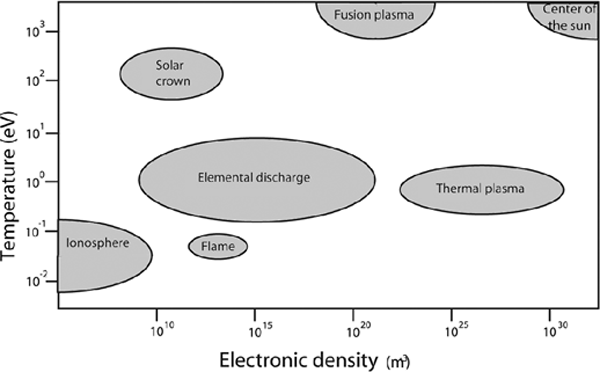2.2. Plasma and its characteristics
2.2.1. Plasmas
Plasmas are the fourth state of matter after solids, liquids, and gases, and over 99% of the universe is in plasma state [IGN 92]. Plasma is an ionized gas, considered to be electrically neutral both at the macroscopic scale and in its entirety: this property is known as quasi-neutrality (and does not only applies to the neutrality of the plasma as a whole, but also to certain parts thereof) [BAC 95]. It consists of a mix of different cohabiting species: light particles (electrons), heavy particles in either their ground or excited states (atoms, molecules, and ions), and massless particles (photons).
Since plasmas can exist in a large pressure range, it is more convenient to class them as a function of electronic temperature and electronic density (1 eV = 7,740 K, as per the Stefan–Boltzmann distribution) [FAU 87]. Figure 2.1 shows the different types of plasma, which imply the existence of some natural plasmas in the universe.
Figure 2.1. Temperature diagram as a function of electronic density

In thermal plasma, also known as hot plasma, the kinetic energies of the electrons and the heavy particles are in the same order of magnitude. Non-thermal plasma (also known as cold plasma), however, is a plasma in thermal disequilibrium, characterized by a large gap between the kinetic energies of the particles. Figure 2.2 shows the temperatures ...
Get Electrothermics now with the O’Reilly learning platform.
O’Reilly members experience books, live events, courses curated by job role, and more from O’Reilly and nearly 200 top publishers.

